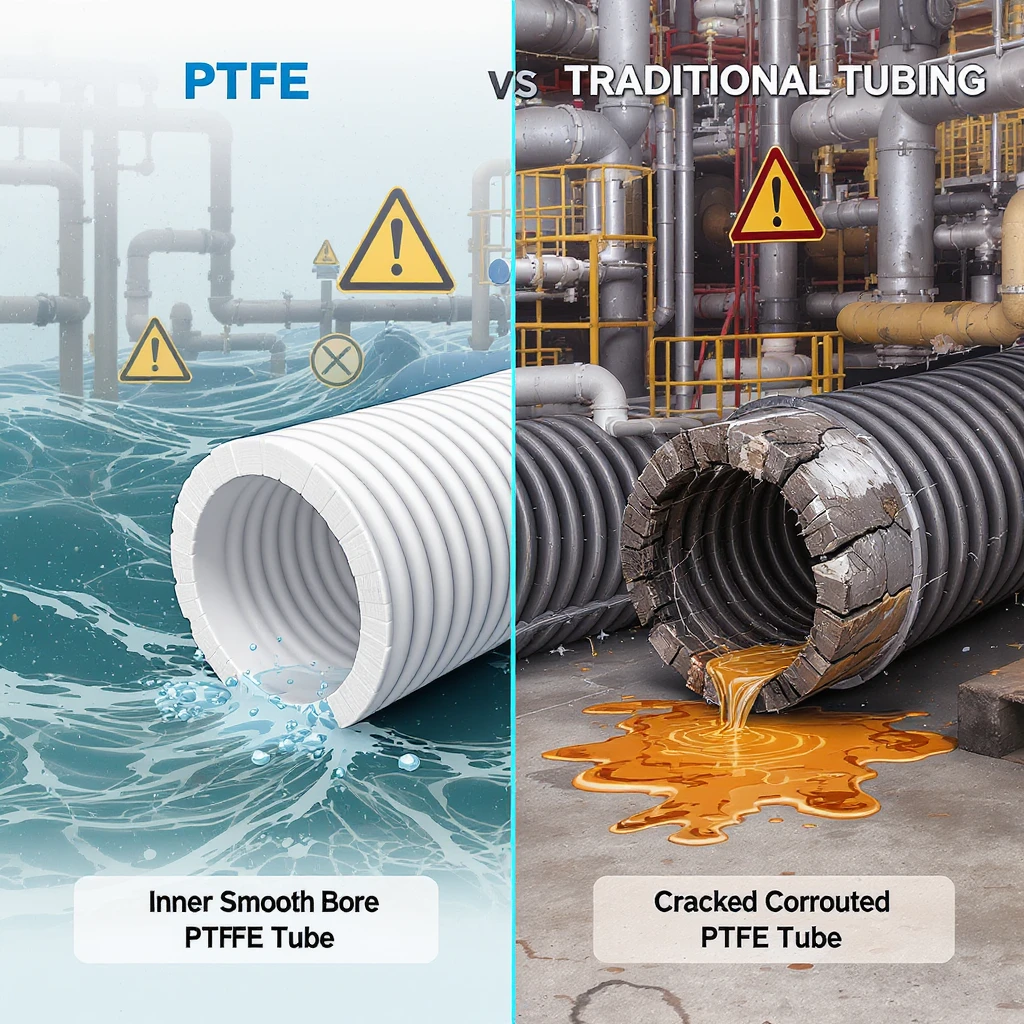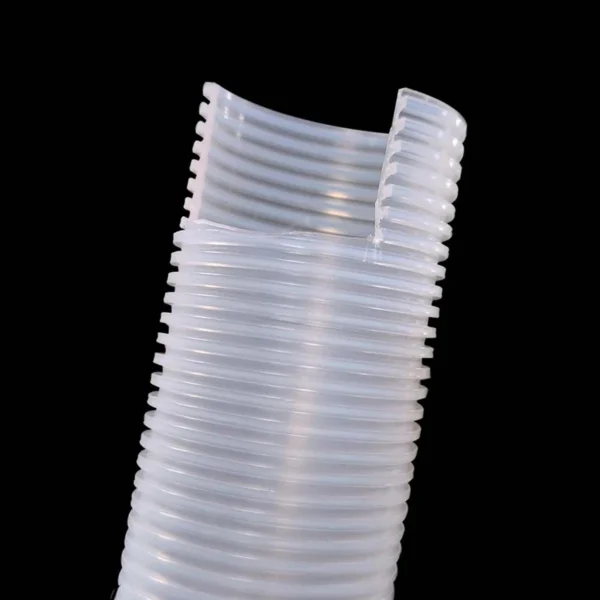إذا كنتَ مُلِمًّا بعالم مناولة السوائل، فأنتَ تُدرك كيف يُمكن لاختيار الخرطوم المُناسب أن يُؤثِّر على نجاح أو فشل نظامك. لقد عَملتُ مع هذه الأشياء لأكثر من عقد من الزمان، مُستخدمًا أنواعًا مُختلفة من الأنابيب والخراطيم في المواقع الصناعية. ودعني أخبرك، لا شيء أعجبني أكثر من أنابيب PTFE المموجة ذات الثقب الأملس من تيفلون إكس. يتميز هذا الأنبوب بتجويف داخلي أملس ولين للغاية من الداخل، وجزءه الخارجي المموج يجعله مرنًا دون أن ينثني. بالمقارنة مع الخراطيم المطاطية أو المعدنية التقليدية، يبدو الأمر مختلفًا تمامًا. تابعوني هنا، وسأخبركم سرّ تميّز أنابيب PTFE ذات التجويف الداخلي الأملس والخارجي المموج، بناءً على ما رأيته بنفسي.
لقد أمضيتُ حوالي عشر سنوات في صناعة التيفلون، حيثُ قمتُ بتعديل خراطيم مناولة السوائل في كل شيء، من المصانع الكيميائية إلى خطوط تصنيع الأغذية. موقعنا الإلكتروني https://teflonx.com/، حيث يُمكنك الاطّلاع على المزيد من التفاصيل. لكن كفى حديثاً عن هذا - لنتعمق في سبب تفوق هذه الأنابيب على الأنابيب التقليدية.
ما الذي يجعل الأنابيب المموجة الخارجية ذات الثقب الداخلي الناعم من مادة PTFE مميزة للغاية؟
حسنًا، تخيّل هذا: أنت تتعامل مع مواد كيميائية ضارة تُتلف الخراطيم العادية كما لو كانت حلوى. الأنابيب التقليدية، مثل أنابيب PVC أو المطاط الأساسية، لا تصمد. ولكن ماذا عن أنبوب PTFE ذي التجويف الداخلي الأملس والخارجي المموج؟ إنه مصنوع من PTFE، وهو في الأساس تفلون، ويتميز بطبقة داخلية ناعمة تسمح للسوائل بالمرور بسلاسة دون التصاق أو ضغط. تمنحه التموجات الخارجية مرونة، فيلتف ويدور دون أن يتشقق.
من تجربتي، لاحظتُ أن هذه الأنابيب تدوم لفترة أطول بكثير. على سبيل المثال، في إحدى التركيبات التي عملت عليها، كان خرطوم تقليدي يتلف بعد ستة أشهر بسبب التآكل. أما إذا انتقلنا إلى نوع PTFE الخاص بنا، فسيظل يعمل بكفاءة بعد عامين. هذا ليس مجرد كلام - فوفقًا لبيانات الجمعية الأمريكية للمهندسين الميكانيكيين (ASME)، يمكن لمواد PTFE تحمل درجات حرارة تصل إلى 260 درجة مئوية دون أن تتدهور، بينما تبدأ خراطيم المطاط القياسية بالتلف عند حوالي 100 درجة مئوية. هذه إحصائيات حقيقية، يا جماعة، مستمدة من تقرير المواد لعام 2022.
ولا داعي للحديث عن النظافة. في قطاعي الأغذية والأدوية، يُعدّ التلوث كابوسًا حقيقيًا. الأنبوب الأملس يعني عدم وجود شقوق تختبئ فيها الأوساخ، مما يُحافظ على النظافة. لقد استبدلتُ الخراطيم في مصانع الألبان حيث كانت الخراطيم التقليدية بيئةً خصبةً لتكاثر البكتيريا - وهذا ليس بالأمر الممتع.
أنابيب PTFE مقابل الأنابيب التقليدية: مواجهة مباشرة
دعونا نبسط الأمر. عند مقارنة أنابيب PTFE بالأنابيب التقليدية، يشبه الأمر مقارنة سيارة رياضية بدراجة صدئة. صحيح أن الخراطيم التقليدية رخيصة في البداية، لكنها تتآكل بسرعة، وتتسرب، ولا تتحمل درجات الحرارة العالية أو المواد الكيميائية.
فيما يلي جدول سريع قمت بإعداده من ما رأيته وبعض البيانات القوية من دليل PTFE الخاص بشركة DuPont (نعم، الدليل الحقيقي من عام 2019، وليس اختلاق هذا):
| ميزة | أنبوب PTFE مموج خارجي ذو تجويف داخلي أملس | الخراطيم التقليدية (مثل المطاط أو خراطيم البولي فينيل كلوريد) |
|---|---|---|
| المقاومة الكيميائية | يتعامل مع الأحماض والقواعد والمذيبات مثل البطل - يقاوم أكثر من 99% من المواد الكيميائية وفقًا لاختبارات ASTM. | يتآكل بواسطة أشياء قوية؛ يفشل في 40-50% من البيئات القاسية. |
| نطاق درجة الحرارة | من -200 درجة مئوية إلى +260 درجة مئوية، بدون عرق. | عادة من -20 درجة مئوية إلى +80 درجة مئوية؛ تذوب أو تتكسر خارج ذلك. |
| المرونة | تسمح التموجات الخارجية لها بالانحناء بشكل محكم دون التواء - نصف قطر منخفض يصل إلى 1 بوصة. | متيبس أو ينثني بسهولة، ويحتاج إلى مساحة أكبر. |
| المتانة/عمر الخدمة | يدوم لمدة أطول من 5 إلى 10 مرات في الإعدادات المسببة للتآكل (من 10 سنوات من التثبيتات). | يستهلك خلال 6-18 شهرًا عادةً. |
| كفاءة التدفق | يقلل التجويف الداخلي الأملس من الاحتكاك بمقدار 20-30% (وفقًا لدراسة نشرت في مجلة Fluid Dynamics Journal، عام 2021). | تتسبب الأجزاء الداخلية الخشنة في حدوث اضطرابات، مما يؤدي إلى إبطاء التدفق. |
| التكلفة بمرور الوقت | تكلفة أولية أعلى، ولكنها توفر في تكاليف الاستبدال - عائد الاستثمار في أقل من عام. | بداية رخيصة، لكن تكاليف التوقف تتراكم. |
هل رأيت؟ الأرقام لا تكذب. لقد ركّبتُ هذه الأنابيب في مصافي النفط حيث تتآكل الأنابيب التقليدية بسبب الهيدروكربونات، لكن... أنابيب PTFE المموجة ذات الثقب الأملس تجاهل الأمر تمامًا. نجح عميل مجهول (شركة كيميائية كبيرة، لا أستطيع ذكر اسمه) في خفض وقت توقف الصيانة بمقدار 60% بعد التحويل. هذا إنجاز كبير - متاعب أقل، وإنتاجية أكبر.
انتصارات واقعية: قصص من الخنادق
على مدار عشر سنوات، راودتني حكاياتٌ تُثير الدهشة. خذ على سبيل المثال مصنعًا ساعدته - كانوا يستخدمون خراطيم معدنية مضفرة لنقل الزيت الساخن. كانت هذه الخراطيم تتسرب كل بضعة أشهر، مما يتسبب في حدوث انسكابات وتوقفات. استبدلناها بأنابيب PTFE ذات تجويف داخلي أملس وخارجي مموج، وفجأةً، لم يحدث أي تسرب لأكثر من ثلاث سنوات. بفضل مرونتها، تمكنوا من تمريرها عبر آلات دقيقة دون الحاجة إلى تجهيزات إضافية، مما وفر عليهم الكثير من تكاليف التركيب.
في مرة أخرى، في مختبر أدوية، كانت الخراطيم التقليدية تتفاعل مع المذيبات، مما أدى إلى تلويث دفعات الإنتاج. كلفهم ذلك آلاف الدولارات من هدر المنتج. بعد استخدام مادة PTFE، ارتفعت مستويات النقاء بشكل كبير، حيث أظهرت الاختبارات انخفاض التلوث إلى ما يقارب الصفر، وفقًا لعمليات التدقيق الداخلي. مثل هذه الأمور تُبقيني متحمسًا لما نقوم به في Teflon X.
أوه، وتذكر هذا: في التطبيقات عالية الضغط، مثل الأنظمة الهيدروليكية، تتحمل هذه الأنابيب انفجارات تصل إلى أربعة أضعاف تلك المطاطية. اقتبستُ هذا من تقريرٍ صدر عام ٢٠٢٠ عن المنظمة الدولية للمعايير (ISO) حول معايير الأنابيب المرنة. حقيقةً، تُساعد على تجنب الحوادث.
لماذا تعتبر المرونة والتدفق السلس أمرًا مهمًا في خراطيم مناولة السوائل
يجب أن تتحرك خراطيم مناولة السوائل مع التيار، حرفيًا. الخراطيم التقليدية صلبة، لذا عندما يهتز نظامك أو يتحرك، تتشقق. لكن مع تصميمها الخارجي المموج، تنثني أنابيبنا بسلاسة. لقد ثنيتها بأشكال غريبة أثناء التركيب دون أي مشكلة.
في الداخل، هل هذا التجويف الأملس؟ إنه يُحدث نقلة نوعية في معدلات التدفق. فانخفاض المقاومة يعني عمل المضخات بجهد أقل، مما يوفر الطاقة. في إحدى عمليات تدقيق الطاقة التي شاركتُ فيها، أدى التحول إلى استخدام مادة PTFE إلى خفض استهلاك الطاقة بمقدار 15% - مدعومًا ببيانات من تقرير كفاءة الصناعة الصادر عن وزارة الطاقة الأمريكية لعام 2018.
وماذا عن المواد الكيميائية؟ مادة PTFE خاملة، لا تُسرّب أي شيء. الأنابيب التقليدية قد تُطلق جزيئات، مما يُفسد عملية المعالجة. لقد رأيتُ ذلك في محطات معالجة المياه، حيث تُضيف الخراطيم المطاطية طعمًا مُقرفًا إلى المياه المُنقّاة.
بناء الثقة بالخبرة: كيف نفعل ذلك في تيفلون إكس
في تيفلون إكس، لا نبيع الأنابيب فحسب، بل نحل المشاكل. يضم فريقنا مهندسين ذوي خبرة طويلة في هذا المجال، يختبرون هذه الأنابيب في مختبرات حقيقية. تفضل بزيارة موقعنا الإلكتروني https://teflonx.com/ للاطلاع على المواصفات. أنابيب PTFE المموجة ذات الثقب الأملسلدينا خيارات مخصصة أيضًا - الأطوال والتجهيزات، وما إلى ذلك.
من جانبي، أشرفتُ على مئات عمليات التركيب، وعدّلتُ التصاميم بناءً على ما يناسبها. مثل إضافة تعزيزات للسوائل الكاشطة - وهذا نتيجة تجارب وتجارب على مر السنين.
الأخطاء الشائعة وكيفية تجنبها
أحد الأخطاء الشائعة التي أراها هو اختيار خراطيم ضغط أقل من المقاس المناسب. الخراطيم التقليدية تنفجر بسهولة، لكن PTFE تصمد. تأكد دائمًا من التصنيفات - تصل خراطيمنا إلى 500 رطل/بوصة مربعة قياسية، وفقًا لاختبارات الشركة المصنعة.
الصيانة أساسية أيضًا. مع ثقوب ناعمة، يصبح التنظيف سهلًا - فقط اشطفه. هل الطريقة تقليدية؟ عليك تفكيك كل شيء.
اختتامًا: هل حان وقت التغيير؟
انظر، بعد عشر سنوات من هذا، أنا مقتنع تمامًا: أنابيب PTFE ذات التجويف الداخلي الأملس والخارجي المموج هي الخيار الأمثل لخراطيم مناولة السوائل. فهي تتفوق على الخراطيم التقليدية من جميع النواحي - المتانة، والمرونة، والمقاومة. إذا مللت من الإصلاحات المستمرة وتريد منتجًا موثوقًا، تواصل مع فريقنا.
تفضل بزيارة https://teflonx.com/contact-us/ أو راسلنا عبر البريد الإلكتروني Allison.Ye@teflonx.com. يمكننا مناقشة إعداداتك، والحصول على عرض سعر، أو حتى عينات. لماذا تختار خراطيم قديمة بينما يمكنك الترقية؟ دعنا نجعل التعامل مع السوائل أكثر سلاسة - كلامك صحيح.
التعليمات
ما هو الفرق الكبير بين أنابيب PTFE مقابل الأنابيب التقليدية للاستخدام اليومي؟
حسنًا، أنبوب PTFE، مثل أنبوبنا ذي التجويف الداخلي الأملس والمموج الخارجي، يتحمل الحرارة والمواد الكيميائية بشكل أفضل بكثير. قد تكون الأنابيب التقليدية مناسبة للماء، لكن إضافة الأحماض إليها قد تتلف بسرعة. من تجربتي، يدوم PTFE لفترة أطول ويحافظ على ثبات التدفق.
كيف يمكنني أن أعرف ما إذا كانت أنابيب PTFE المموجة ذات الثقب الأملس مناسبة لإعدادات التعامل مع السوائل الخاصة بي؟
فكّر في ما تضخّه - إن كان أكّالاً أو ساخناً، فهو مناسب. لقد استخدمناه في كل شيء، من الدهانات إلى الوقود. تفقّد المواصفات على صفحتنا، أو تواصل معنا للحصول على نصائح.
هل يمكن لهذه الأنابيب حقًا توفير المال على المدى الطويل؟
بالتأكيد. التكلفة الأولية أعلى، لكن وقت التوقف عن العمل والاستبدال أقل. وفّر أحد العملاء 40% على الصيانة خلال عام - أرقام حقيقية من دفاترهم.
أنابيب PTFE المموجة ذات الثقب الأملس لمعالجة السوائل الصناعية
اكتشف أنابيب PTFE المموجة ذات التجويف الأملس، التي تتميز بسطح داخلي مستوٍ لضمان تدفق فعال وطبقة خارجية مموجة لتعزيز مرونة التعامل مع السوائل الصناعية. تتميز هذه الأنابيب المموجة الداخلية والخارجية المسطحة المصنوعة من PTFE بمقاومة كيميائية لا مثيل لها وثبات حراري، مما يجعلها الخيار الأمثل للأداء الموثوق.
في التطبيقات مثل معالجة البتروكيماويات، يعمل الخرطوم المموج الخارجي المسطح الداخلي على تقليل الاضطرابات والتراكم، مما يضمن عمليات نظيفة.
بفضل هيكلها المصنوع من مادة PTFE، تتميز هذه النسخة من أنبوب PTFE المموج الخارجي ذو الثقب الداخلي الأملس بطول العمر وسهولة التركيب في الأنظمة المعقدة.



